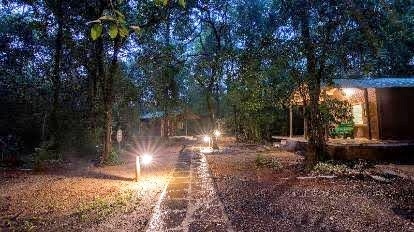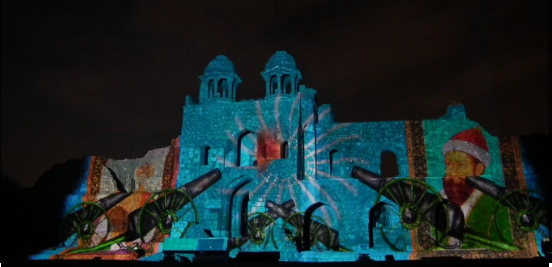Unveiling the mysteries: Ghostly whispers at Seethanadi Nature Camp.
In the evening, I was shown a nice documentary on the King Cobra as we were inside the Someshwara Wildlife Sanctuary near Augumbe which is famous for its snake population. After the documentary was over, I went off to sleep thinking about the role of snakes in the ecosystem and how the snakes were responsible for controlling the rodent and frog population and in turn were controlled by peacocks and mongoose.
Early in the morning, I was woken up from my dreams about snakes by a ghostly “whoo - hoo” haunting sound. I felt as if a ghost was outside my tent and making sounds which were followed by an attack of twigs and fruits falling on the roof of my tent. I was a bit frightened and as it was almost dawn, I switched on my torch and went towards the Manager's office which was located near the Seethanadi River.
As I reached the Manager's office, I heard a strange sound as if there was a machine gun firing at a distance and then the sound stopped. The silence was broken by the loud laughing of a wicked lady which seemed to be coming from the riverside nearby. The situation was a bit frightening, and I heard a heavy wooden door creaking open and was sure the place was haunted. I soon heard a small baby crying very loudly and luckily it was fully bright now and I saw the staff of Jungle Lodges coming towards me with a tray of tea and biscuits.
The guy was very friendly and told me that we could either go for a trek or a coracle ride in the river. I told him about my whole experience since waking up in the morning and he explained that the ghostly “whoo -hoo” sound was made by the langurs in the morning as they were jumping around the tree on top of my tent and that caused the dry twigs and fruits to drop on the tent. The strange sound of a machine gun was heard once again and he told me that it was made by the Malabar squirrels, I really felt excited now as I had always been used to hearing the sound of trains, planes, and vehicles in the cities and these sounds were all strange to my ears. We heard the sound of the old, wicked lady laughing once again near the river followed by the loud crying of the small baby and he told me that it was the call of the Stork Billed Kingfisher followed by the Indian Grey Hornbill. We soon heard the sound of the heavy wooden door creaking open and he told me that it was the sound of the Malabar Woodpecker, pecking on a heavy timber tree.
Just like we live near our place of work which gives us money for our food, the birds it seems always lived near their sources of food. Like migratory birds, I was a migratory worker who relished the Udupi cuisine.
The guide told me that Birding was one of the topmost recreational activities in the world and I couldn’t agree more as I had joined the Manipal Birders Club and every Sunday we went out on some amazing trails.
The wetland or aquatic birds could be seen in Manipal Lake, Swarna River, and the Mangroves and my favorites were Spoonbill, Ibis, Egrets, and Herons as their landing were always very graceful like an aircraft touching down smoothly on the runway.
I always loved to watch the raptors or birds of prey as they soared high in the sky, turning tightly in circles in the thermals and they had excellent eyesight and binocular vision, strong feet, and sharp talons for hunting. My favorites were the Brahminy Kites, Eagles, and Falcons.
Among the ground-feeding or terrestrial birds, I loved the Malabar Whistling Thrush which whistled like a schoolboy. The Grey Junglefowl shouted the most and the Peacocks were always busy showing off their plumage and colorful bodies like Bikini Models.
The aerial feeding birds could always be seen feeding on insects and flies above the river and waterbodies and were fast fliers like fighter planes and included Swifts and Swallows.
The real colorful and photogenic birds were the arboreal birds whose life cycle was associated with trees and shrubs as they fed on ants, termites, caterpillars, fruits, and insects. My favorites were the Malabar Pied Hornbill, Indian Paradise Flycatcher, Orioles, and Orange Minivets.
 |
| Photos by members of Manipal Birder's Club. |
At the end of the trip, I was suddenly reminded about the Sound and Light Show held at Red Fort in Delhi and how the show transported us back to the time of the Mughal Emperors. However, the morning at Seethanadi Nature Camp managed to transport me to a paradise on Planet Earth.
I later learned to use the Merlin App for recording the sound of birds for easy identification along with the eBird App to do my birding in a more focused manner and not let my wild imagination play tricks with my fertile mind.








Comments
Post a Comment